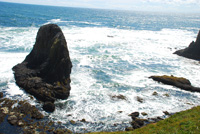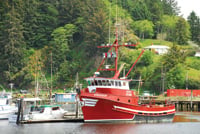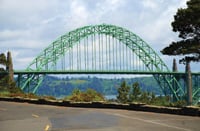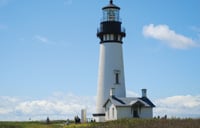 Sliding down sand dunes on a board; donning gloves to create glass art in a 600-degree furnace; climbing a ladder into the dome of a working lighthouse. What novel experiences you can have if you linger in the little towns along the Oregon coast! Like too many RV travelers, when I cruised down the coast on U.S. Highway 101, I seldom went far off the road except to fill up with gas. I was always going somewhere. This time I was a wanderer, an explorer, a gypsy, soaking up the real life of the small towns.
Sliding down sand dunes on a board; donning gloves to create glass art in a 600-degree furnace; climbing a ladder into the dome of a working lighthouse. What novel experiences you can have if you linger in the little towns along the Oregon coast! Like too many RV travelers, when I cruised down the coast on U.S. Highway 101, I seldom went far off the road except to fill up with gas. I was always going somewhere. This time I was a wanderer, an explorer, a gypsy, soaking up the real life of the small towns.
From Portland, we drove on a secondary road that meanders southwest through rolling wine country, a distraction left for later. A breeze laced with salt and evergreen announced our arrival at Lincoln City. Registration and hookup at Premier RV Park went smoothly and, before the sun sank slowly over the Pacific, we were ordering dinner at the Fathoms, the Inn at Spanish Head’s fine view restaurant across the street from Premier.
While Lincoln City has a good, family-oriented restaurant at the Chinook Winds Casino Resort a few blocks to the north, we opted for next day’s lunch in a cooking class at Culinary Center, an enterprise underwritten by the city to expose tourists to Northwest cuisine. Sharon Weist, a chef from New York, and Liz Lesesne, graduate of the Midwest Culinary Center, created a lunch of local marionberry galette, local greens and dessert, enhanced by Oregon wines. We watched every move from our counter chairs, enjoying a running commentary. The center offers a class once weekly for tourists and for special events like reunions and Elderhostel groups (25-35 people). Any traveler can reserve a session for a smaller group in advance of arrival, as well.
 Creating Art
Creating Art
Recognizing that beachcombers love to find glass fishing balls, the city gurus appoint a local person to sneak out by dark and hide glass balls on the beach for visitors to find. I walked the beach and finally found one stuffed into a hole in a driftwood log. This experience made the Glass Art Studio off the highway more meaningful when I donned a heatproof apron and long mittens to create my own glass ball under the close shepherding of glass blower John Meyers. The process involved several rounds of holding a long rod wound with the raw materials into a 600-degree furnace to melt the glass, then swiftly turning the rod so the end stayed round. I twisted the partly molten mass with pliers to create swirls. Finally, I blew through a long tube to expand the mass into a ball with striped colors, my own creation. After an overnight cooling process, the ball was mailed to my home, since I was driving on that day.
At Newport, south of Lincoln City, The Edge glass art studio specializes in creating a custom piece of art that includes a portion of the “cremains” of one’s beloved departed. “No!” I exclaimed.
“True,” artist Ryan Bledsoe replied. “At first I felt the same when a widower asked me to do this. Now I realize it is comforting to have a tangible memorial of a loved one.”
The artist told of a man mourning for his dog who collected bits of toys and beach objects that his dog always loved to play with and placed them, along with the dog’s cremains, within a hollow glass ball. The man still has his beloved dog with him in spirit and reality.
River Adventures Still hugging the water, we drove on to Yaquina Bay, well off Highway 101, where we were tempted by crabbing at Sawyer’s Landing RV and Marina, a small but scenic place. The marina had everything we needed—crab pots, a rental boat and good advice. Before evening we had a feast to prepare of crab and sourdough bread we had picked up.
Still hugging the water, we drove on to Yaquina Bay, well off Highway 101, where we were tempted by crabbing at Sawyer’s Landing RV and Marina, a small but scenic place. The marina had everything we needed—crab pots, a rental boat and good advice. Before evening we had a feast to prepare of crab and sourdough bread we had picked up.
A change of pace took us eight miles up the Yaquina River the next day to Toledo. It was formerly a lively logging and fishing town, but today art and tourism are its emphasis, although the paper mill still exists to process recycled materials and small logs for pulp. Myriads of birds—blue herons, egrets, bald eagles, purple martins—call this backwoods area their winter home. The river itself is home to new commercial freshwater oyster farms. Boats chug down the river to the sea along a stretch made immortal in the popular movie, Sometimes a Great Notion.
Who would expect the major Yaquina Pacific Railroad Museum to be way off the beaten path at Toledo? Retired gandy dancer Tom Chandler, dressed in a railroad worker’s striped overalls and cap, proudly told us the lore of the steam trains that ran along the river into the woods. The museum seeks out obscure pieces like the 1910 Velocipede railroad handcar, its rider’s job to keep the lamps full of oil. I marveled at the restored 1923 Southern Pacific post office car with sorted mail in little compartments. A “rail mail service clerk” lived part-time in the car, where a can in a corner constituted the bathroom. The clerk wore a gun to protect the sacrosanct United States mail. This unusual nationwide service lasted in some areas until 1977-79!
Far from the main highway in Toledo, brilliant artist Sam Briseno creates his steel sculptures that have received international attention through online exposure. Entering Toledo, I had wondered about the fancy benches and whimsical sculptures scattered about the little community. Sure enough, it was Briseno’s work, much of it commissioned. The back of one bench is in the shape of a blue heron. Another is a replica of beloved resident Bill McKay’s boat.
“Bill was a butcher here in town,” said Briseno. “He had a wooden boat and always loved kids. He was a pipe-smoking joker and a lot of fun. When he died, his wife, Irene, commissioned a bench that faced the Depot Slough where he used to sit and watch the boat traffic.”
Cliffs and Sand Continuing south on Highway 101 to Yachats, we arrived at the Sea Perch RV Park, which is small but enjoys a dramatic view of the ocean. South of Yachats, towering cliffs rise above the beaches, and along the cliffs is the Heceta Head Lighthouse, where the assistant lightkeeper’s home is now a historic bed and breakfast inn. South of these formidable cliffs, for decades the prevailing southwest winds have blown acres of sand inland to create dunes. A growing sport is sandboarding on steep dunes, like snowboarding on snow.
Continuing south on Highway 101 to Yachats, we arrived at the Sea Perch RV Park, which is small but enjoys a dramatic view of the ocean. South of Yachats, towering cliffs rise above the beaches, and along the cliffs is the Heceta Head Lighthouse, where the assistant lightkeeper’s home is now a historic bed and breakfast inn. South of these formidable cliffs, for decades the prevailing southwest winds have blown acres of sand inland to create dunes. A growing sport is sandboarding on steep dunes, like snowboarding on snow.
Sand Master Park near Florence has its own big sand dune for practice and was managed by two grinning teenagers, who could throw themselves down the biggest dune like slalom racers. Of course, we had to try it out. Trudging 400 feet up a slippery, 70-degree dune and dragging a specially designed board behind took some effort. The ride down, poised as if on a ski slope, was just plain fun. I was in the sand as much as on it but was more than willing to labor uphill for more runs.
Later, with a helmet and strapped securely into the seat of a sand runner near Newport, I would scream at the outrageous speed we achieved over the dunes. We soared up the edge of a dune as if it were a surfing wave and curved down again, hurtled over the edges of seemingly vertical slopes safely, and explored the entire wilderness of sand. Surprisingly dune guardians welcome ATVs and dune buggies to help slow the encroachment of non-native beach grasses that threatens to prevent the natural flow of sand from the ocean.
For years we had sped along Highway 101 through the busy town of Reedsport. At its southern end I had never seen the sign that modestly points to Winchester Bay off to the east, pop. 450. An entire off-highway peninsula awaited my exploration. First of all, I was excited to learn that we could park at the Discovery Bay RV Park on Half Moon Bay and take off from there in an ATV (rented on-site) directly onto a huge dune complex. An annual Dunefest in Reedsport and Winchester Bay that features ATV or dune buggy races and jumping competitions attracts as many as 8,000 people, some lucky enough to find space in rentable condos. No alcohol is allowed on the dunes and speed limits are enforced at this family-oriented event.
Several curving miles south at the Umpqua River Lighthouse, I climbed a steel ladder to stick my head into the colorful red and yellow expanse around the Fresnel lens, one of the oldest existent. Each of the 616 pieces is hand-ground, bending the light into the proper pattern. An adjacent museum tells the story of the keepers and crews, for from 1878-1915 this site was an Umpqua Life-saving Station created to rescue seamen trying to enter the river from this dangerous section of Pacific Coast.
On a small road, nine-hole Forest Hills Golf Club has a restaurant and lounge in the clubhouse to serve tired golfers and wanderers like me, a place to watch the golfers flub their shots or make a hole in one. Winchester Bay also sports marinas, a large U.S. Coast Guard station, and seafood restaurants like the Schooner Café and its sinful desserts.
All this behind that little 101 highway sign saying “Winchester Bay.” I never even knew it existed, which really pinpoints the reason for slowing down to truly enjoy the sights and sites along the busy Oregon highway. On my next trip, I intend to follow this same pattern and see what else is out there to enjoy along more miles of Oregon’s 101. n
JoAnn Roe is a writer and photographer with more than 700 articles in newspapers and magazines. She lives in Bellingham, Washington.

Leave a Reply